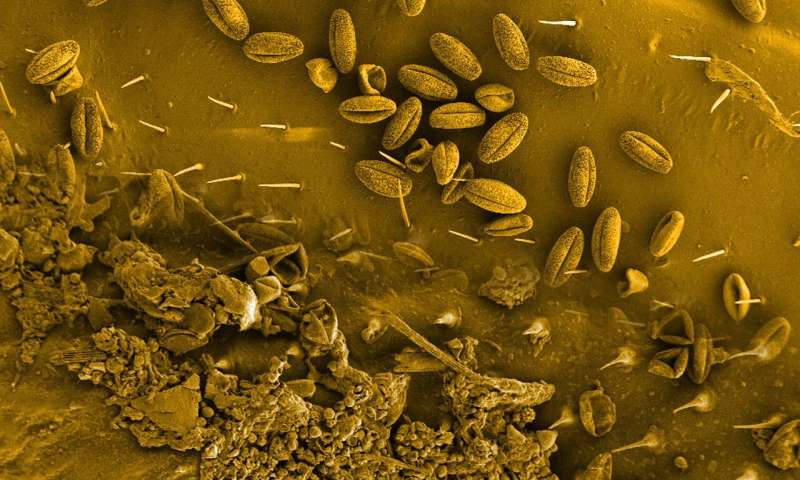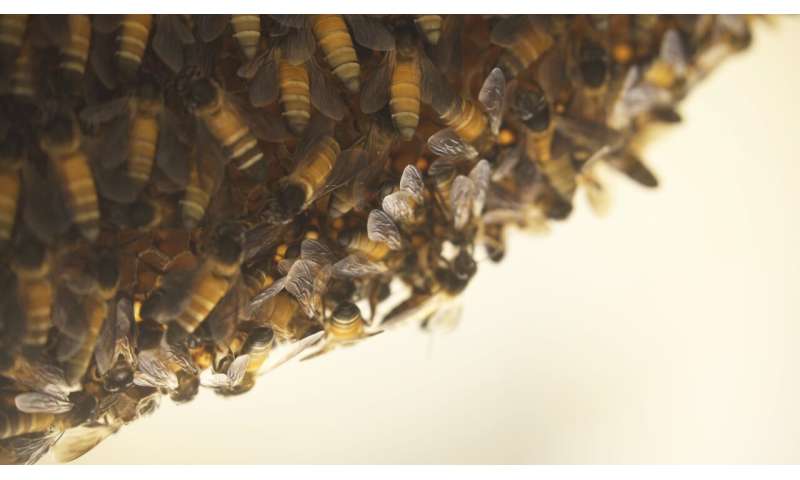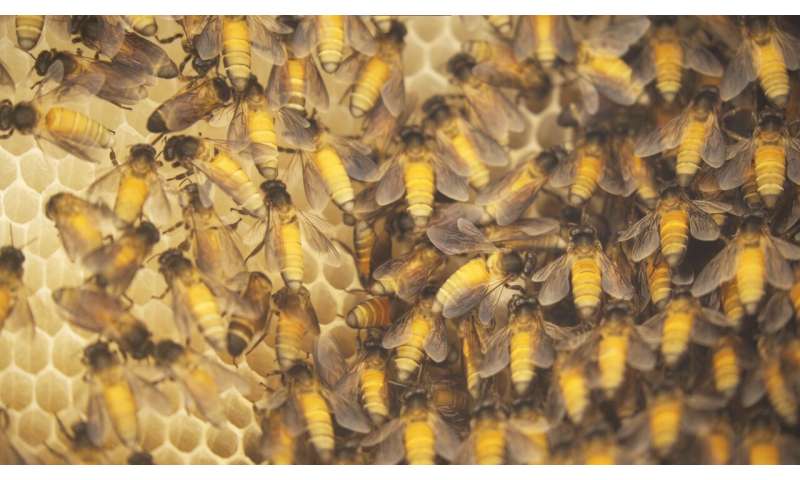by National Centre for Biological Sciences
AUGUST 10, 2020

Pseudocolorized, non-coated scanning electron micrographs of two foraging Giant Asian honeybee (Apis dorsata) wing regions, one (top) collected from a low polluted site in Bangalore, India (average respiratory suspended particulate matter, RSPM10 particles < 10 μM at 33.7 μg/m3) and one (bottom) collected from a highly polluted site 7.7 km away (average RSPM10 at 98.6 μg/m3). Note the presence of pollen (top) and RSPM (bottom) in the images. Credit: Micrograph obtained by Geetha Thimmegowda with a Zeiss merlin compact VP microscope at 1 kV EHT and 460X magnification.
According to the World Health Organization (WHO), nine of the world's 10 most polluted cities are in India. Yet, researchers have almost no idea how air pollution is affecting non-human organisms. In some of the first research to address the physiological and molecular impacts of air pollution on wild plants and animals, scientists from the Bangalore Life Science Cluster show that air pollution could be devastating for organisms humans rely on most for survival, like the honey bee.
Apis dorsata, or the giant Asian honey bee, is not only a common resident of Indian cities, but it is an important contributor to India's food security and ecosystems. This bee produces over 80% of the country's honey, and pollinates over 687 plants in Karnataka alone. Seventy-five percent of Indian crop species rely to some extent on animals, and mostly insects, for their production. India is the largest fruit producer and second-largest vegetable producer in the world. Without insect pollinators like honey bees, the yearly mango export would lose over Rs. 65,000 Lacs. The importance of bees and other pollinators to India's plant biodiversity and agroeconomy cannot be overstated.
Led by Shannon Olsson at the National Center for Biological Sciences in Bangalore, Geetha Thimmegowda and colleagues embarked on a four-year study of over 1800 wild bees. Their study was published this week in the Proceedings of the National Academy of Sciences. Through a series of experiments, along with honeybee expert Dr. Axel Brockmann of NCBS and cardiovascular researcher Dr. Dandipany Perunderai of the Institute for Stem Cell Science and Regenerative Medicine (inStem) and the Knight Cardiovascular Institute, the scientists found that giant Asian honey bees from more polluted areas of the megacity of Bangalore exhibited lower flower visitation rates than in less polluted areas. Bees from more polluted areas likewise showed significant differences in heart rhythmicity, blood cell count, and the expression of genes coding for stress, immunity and metabolism. Repeating these experiments with lab-reared Drosophila found similar effects, suggesting that the impact of air pollution is not species-specific, nor likely the result of other environmental factors.

According to the World Health Organization (WHO), nine of the world's 10 most polluted cities are in India. Yet, researchers have almost no idea how air pollution is affecting non-human organisms. In some of the first research to address the physiological and molecular impacts of air pollution on wild plants and animals, scientists from the Bangalore Life Science Cluster show that air pollution could be devastating for organisms humans rely on most for survival, like the honey bee.
Apis dorsata, or the giant Asian honey bee, is not only a common resident of Indian cities, but it is an important contributor to India's food security and ecosystems. This bee produces over 80% of the country's honey, and pollinates over 687 plants in Karnataka alone. Seventy-five percent of Indian crop species rely to some extent on animals, and mostly insects, for their production. India is the largest fruit producer and second-largest vegetable producer in the world. Without insect pollinators like honey bees, the yearly mango export would lose over Rs. 65,000 Lacs. The importance of bees and other pollinators to India's plant biodiversity and agroeconomy cannot be overstated.
Led by Shannon Olsson at the National Center for Biological Sciences in Bangalore, Geetha Thimmegowda and colleagues embarked on a four-year study of over 1800 wild bees. Their study was published this week in the Proceedings of the National Academy of Sciences. Through a series of experiments, along with honeybee expert Dr. Axel Brockmann of NCBS and cardiovascular researcher Dr. Dandipany Perunderai of the Institute for Stem Cell Science and Regenerative Medicine (inStem) and the Knight Cardiovascular Institute, the scientists found that giant Asian honey bees from more polluted areas of the megacity of Bangalore exhibited lower flower visitation rates than in less polluted areas. Bees from more polluted areas likewise showed significant differences in heart rhythmicity, blood cell count, and the expression of genes coding for stress, immunity and metabolism. Repeating these experiments with lab-reared Drosophila found similar effects, suggesting that the impact of air pollution is not species-specific, nor likely the result of other environmental factors.

Giant Asian Honey bee (Apis dorsata) colonies in Bengaluru, India. Credit: Elephant Corridor Films (elephantcorridorfilms.com)
Dr. Hema Somanathan, who studies bee behavior and pollination ecology at the Behavioral and Evolutionary Ecology (BEE) Laboratory, Indian Institute of Science Education and Research, Thiruvananthapuram says, "The study was done with wild bees naturally visiting flowers in Bangalore and not in lab assays on reared honey bees kept in hive boxes that may already be stressed or immuno-compromised. Thus, in my opinion, this study provides us with hard evidence that all is not well with our wild bees. Given the scale of landscape alteration and urbanization in India, it is expected that these effects are widespread and likely to worsen with time."

Dr. Hema Somanathan, who studies bee behavior and pollination ecology at the Behavioral and Evolutionary Ecology (BEE) Laboratory, Indian Institute of Science Education and Research, Thiruvananthapuram says, "The study was done with wild bees naturally visiting flowers in Bangalore and not in lab assays on reared honey bees kept in hive boxes that may already be stressed or immuno-compromised. Thus, in my opinion, this study provides us with hard evidence that all is not well with our wild bees. Given the scale of landscape alteration and urbanization in India, it is expected that these effects are widespread and likely to worsen with time."

Photos of Giant Asian Honey bee (Apis dorsata) colonies in Bengaluru, India. Credit: cC (elephantcorridorfilms.com)
Perhaps most strikingly, the researchers found over 80% of the bees collected from the moderate and highly polluted sites died within 24 hours. These RSPM levels were similar to the Interim Target II guidelines proposed by the WHO. To this end, Arunabha Ghosh, founder and CEO of the Council on Energy, Environment and Water says, "So far, much of the air quality studies in India have either considered sources of pollution or impact on human health, and to an extent on economic productivity. This study covers important new ground, by examining the impact of air pollution on pollinators, which would have serious implications for agricultural output in India. Such findings further underscore the need to raise India's ambient air quality standards."
Finally, Shloka Nath, executive director at the India Climate Collaborative and the Head of Sustainability and Special Projects at Tata Trusts, says, "Better application of research and evidence in development policy-making can save lives, reduce poverty, and improve quality of life. In the case of this study, the research speaks for itself: we now have concrete proof that by polluting our air, we are not only endangering our own health, we are also affecting the wild animals and plants who depend on it for sustenance. This has far-reaching implications for the complex ecosystems we are part of, as these changes affect the quality of habitat and food sources we all depend on."
Explore further Decline of bees, other pollinators threatens US crop yields
Perhaps most strikingly, the researchers found over 80% of the bees collected from the moderate and highly polluted sites died within 24 hours. These RSPM levels were similar to the Interim Target II guidelines proposed by the WHO. To this end, Arunabha Ghosh, founder and CEO of the Council on Energy, Environment and Water says, "So far, much of the air quality studies in India have either considered sources of pollution or impact on human health, and to an extent on economic productivity. This study covers important new ground, by examining the impact of air pollution on pollinators, which would have serious implications for agricultural output in India. Such findings further underscore the need to raise India's ambient air quality standards."
Finally, Shloka Nath, executive director at the India Climate Collaborative and the Head of Sustainability and Special Projects at Tata Trusts, says, "Better application of research and evidence in development policy-making can save lives, reduce poverty, and improve quality of life. In the case of this study, the research speaks for itself: we now have concrete proof that by polluting our air, we are not only endangering our own health, we are also affecting the wild animals and plants who depend on it for sustenance. This has far-reaching implications for the complex ecosystems we are part of, as these changes affect the quality of habitat and food sources we all depend on."
Explore further Decline of bees, other pollinators threatens US crop yields
More information: Geetha G. Thimmegowda el al., A field-based quantitative analysis of sublethal effects of air pollution on pollinators, PNAS (2020).
Journal information: Proceedings of the National Academy of Sciences
Provided by National Centre for Biological Sciences
No comments:
Post a Comment